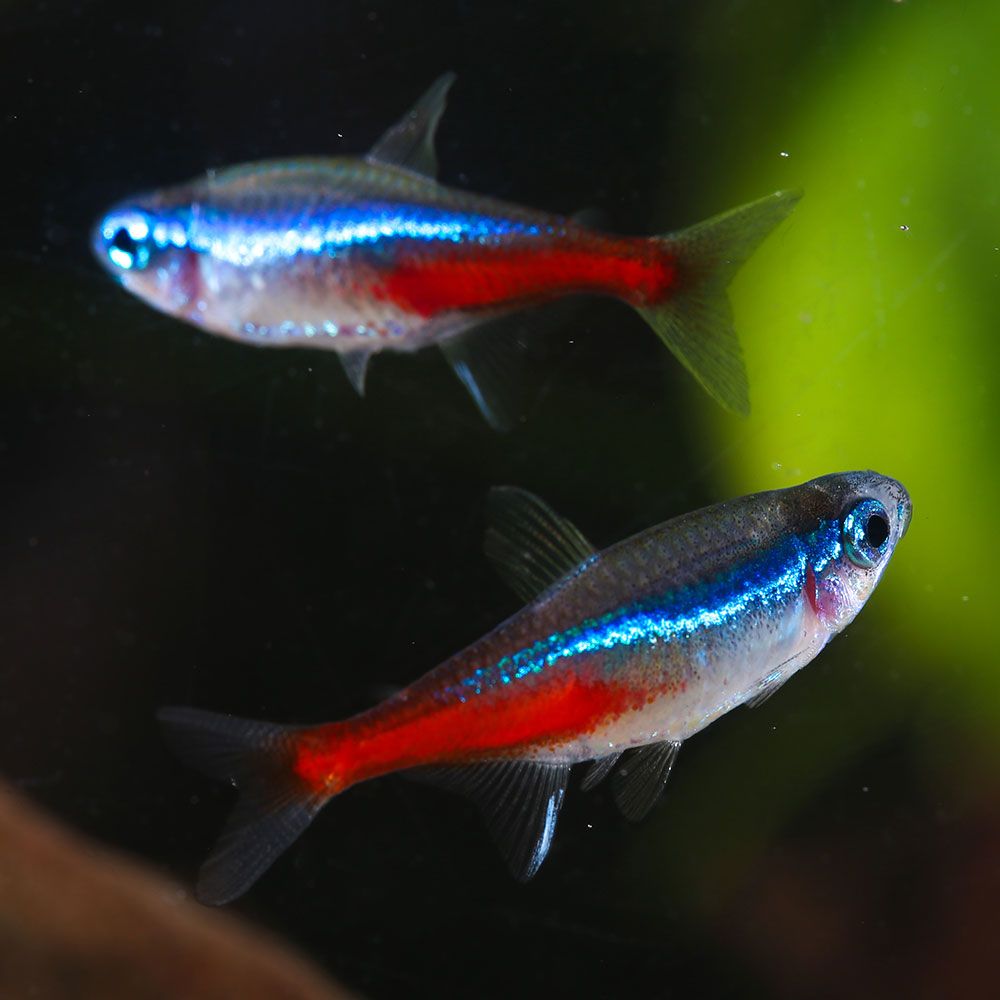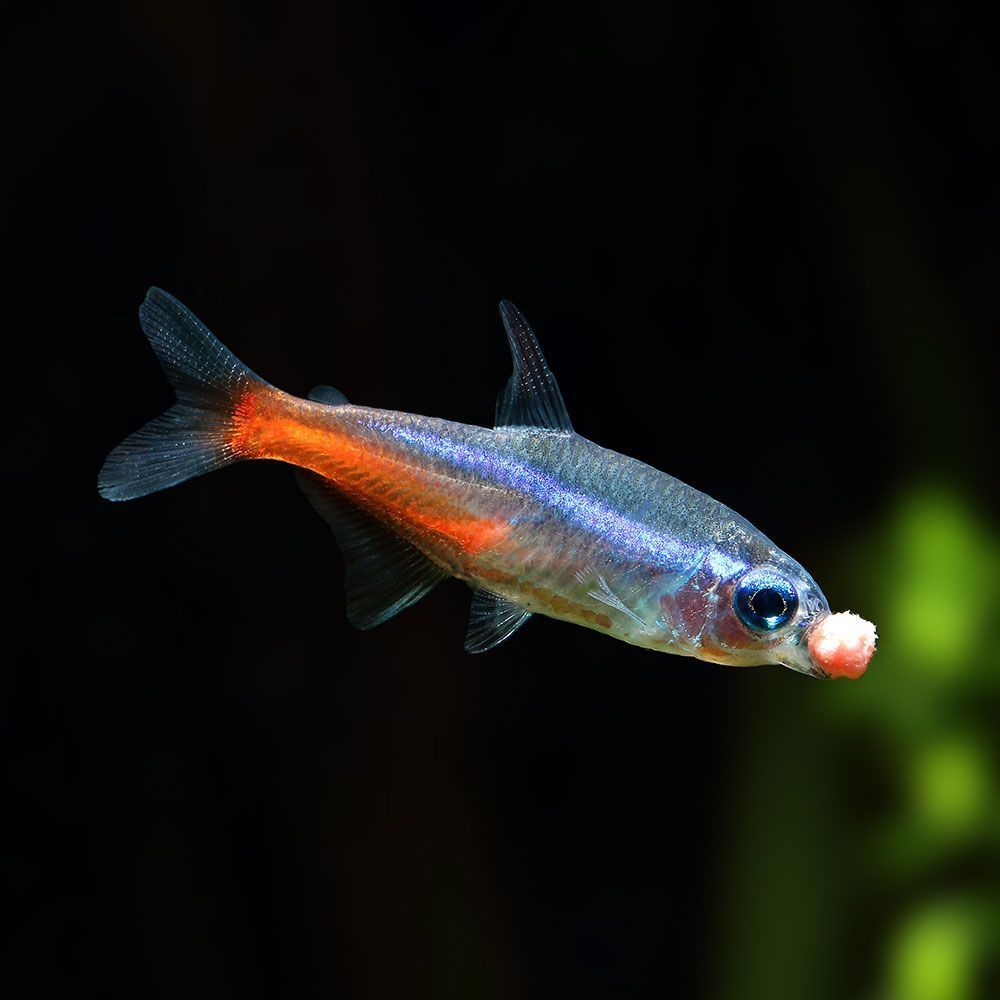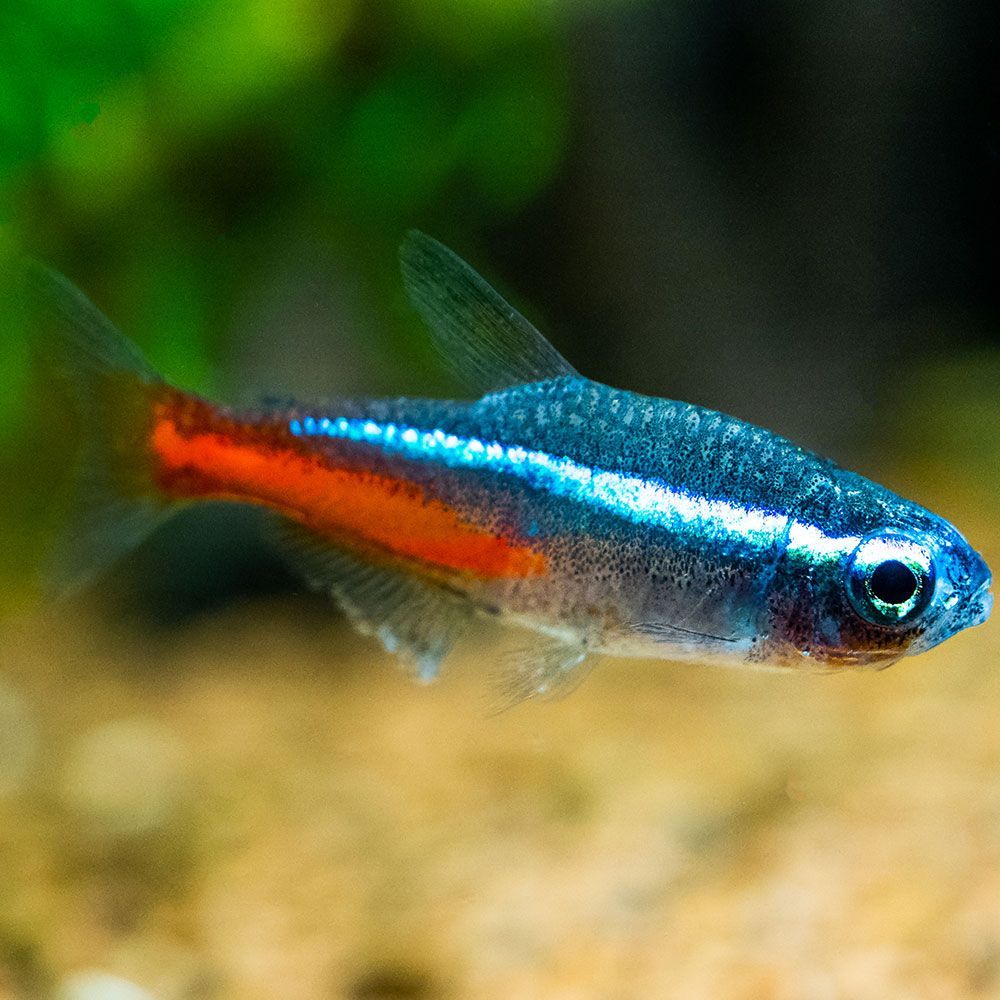When all the neon tetras swim together, they seem like a wave of vibrant-colored gems in your tank!
What is a Neon Tetra?
The neon tetra is one of the most adored and in-demand freshwater fish. It’s inexpensive, calm, and shy, and you won’t have to worry about its compatibility with other fish buddies.
| Origin | Solimões River, South America: blackwater and clearwater stream tributaries |
| Order | Characiformes |
| Family | Characidae |
| Scientific Name | Paracheirodon innesi |
| Common Names | Neon tetra |
| IUCN Red List Status | Not Evaluated |
| Appearance | Slender torpedo-shaped, white-silver belly, blue stripes from nose to adipose fin, red stripe from belly to tail. |
| Size | Up to 3.0 cm (1.18 in) |
| Lifespan | Up to 5 years in captivity |
| Temperament | Peaceful |
| Tank Level | Middle dweller |
| Water Temperature | 70-82 °F (21-28 °C) |
| pH Level | 6.0-7.0 |
| Water Hardness | 4-10 dGH |
| Care Level | Easy to Intermediate |
| Minimum Tank Size | 25 gallons for 10 |
| Tank Environment | Vegetation-rich tank with lots of space to swim and hide |
| Diet | Omnivorous with carnivorous tendencies |
| Tank Mates | Other small and peaceful fish |
What is the Natural Habitat of Neon Tetra?
The fish is naturally found in South American blackwater and clearwater streams of the western and northern Amazon basin. This mainly includes southeast Colombia, east Peru, and west Brazil regions.
Naturally, the species mostly prevails in acidic water (pH 4.0-7.5) at temperatures 68-82 °F (20-28 °C).
It is not native to whitewater rivers and is also introduced to the US and Singapore.
Which family does Neon Tetra belong?
The species belongs to the family Characidae under the order Characiformes. Its scientific name is Paracheirodon innesi.
Fun Fact: The species is a profound algae eater and will clean any algae growth on your tank walls and aquarium vegetation. But it won’t harm your plants!
How does Neon Tetra look?

This fish has a unique luminous appearance and a slim torpedo-shaped body. So, let’s know all about them here.
What is the Size of Neon Tetra?
The average fish can grow as long as 3.0 cm or 1.18 inches.
What is the Color of Neon Tetra?
This fish has a silver-white abdomen and a light blue back. Iridescent blue horizontal stripes run along both sides from the nose to the adipose fin base. It also has iridescent red stripes from both sides of the middle region of the body to the casual fin base.
Other than these prominent, colorful marks, the fish’s body and fins are partially transparent.
What are the Features of Neon Tetra?
The fish’s cells contain guanine crystals, allowing them to change color in different lighting. During the day, when the fish is active, the red and blue stripes are visible. But at night, when the fish rests, the iridescent stripes look somewhat grey to black.
In bright light, the blue stripe ranges from blue to green. It changes to an indigo shade at night, which makes it look more greyish.
It also has a 200 Hz hearing range and 70 dB hearing threshold.
The fish also has an extremely sensitive lateral line system, a line of sensory cells. With it, the fish can detect any vibrations and motion in water. This makes it aware of any possible predators and helps the fish survive in the wild.
What is the difference between a male and a female Neon Tetra?
You can only tell apart the male and female fish if you look closely. The belly of the female fish is a bit larger. The iridescent stripes of the male fish are straight. But the stripes are bent in females.
How does Neon Tetra behave in the tank?
This is a peaceful fish and is ideal for a community aquarium with other similar-sized and similar-tempered fish. It does not act territorial toward its own or other species.
Author’s Note: This fish is often confused with cardinal tetras (Paracheirodon axelrodi). But this distant relative is larger, more vibrant, and more expensive. You can easily tell them apart as the entire abdomen of the cardinals is red, unlike the neon tetras.
What is the Lifespan of Neon Tetra?
Neon tetras can survive till 10 years in the wild. However, captivity-bred ones can only last till 5 years. In my experience, some even lost their pet fish around 2 to 3 years due to poor maintenance.
How to take care of Neon Tetra?

Probably, the news about lifespan got you worried about your pet fish. But don’t fret because you can help them sustain longer by following the below guidelines:
What is the Tank Size of Neon Tetra?
This is a schooling fish, i.e., it feels more comfortable in a group. Otherwise, it gets stressed and catches diseases.
To keep it healthy, you must at least house 10-12 of them together. For this, you need a minimum 25-gallon tank.
If you add more tank mates, increase the tank size consequently.
What is the Water Chemistry for Neon Tetra?
To help your pet fish live the longest, maintain these water parameters in your tank.
- pH Levels: 6.0-7.0>
- Water Temperature: 70-82 °F (21-28 °C)
- Water Hardness: 4-10 dGH
- Carbonate Concentration: 2-6 dKH
- Ammonia: 0 ppm
- Nitrite: 0 ppm
- Nitrate: Below 30 ppm
What should be the Tank Environment for Neon Tetra?
Maintaining an Amazonian biotope for the neon tetras will also help sustain your pet fish. For that, keep these pointers in mind:
Is Substrate required for Neon Tetra?
Any substrate is suitable for the fish. But add river sand substrate to mimic their natural habitat.
Are Plants needed for Neon Tetra?
Create a densely planted tank with peat bog roots to allow them more hiding space. Add driftwood or some twisted branches. You can add plants like java moss, water trumpet, and fishtail fern.
What type of Lighting is needed for Neon Tetra?
Use the dimmest setting of lighting.
What Décor is needed for Neon Tetra?
Add dried oak or beech leaves to tint the water slightly. Make sure to regularly change these to avoid rotting.
What type of Filtration is required for Neon Tetra?
Use a diatom filter to minimize free parasites and protect your pet fish.
What is the Water Flow Rate for Neon Tetra?
It prefers slow-flowing water.
Fish Care Tip
Never add neon tetras to a new tank with unstable parameters, as they are extremely sensitive.
Instead, establish stable water parameters with 25% water change every month and 50% water change every two months.
Once you add the fish, perform a 20% water change weekly and a 50% water change every two weeks.
What does Neon Tetra eat?
It is omnivorous with carnivorous (or insectivorous) preferences. So, make sure you raise them with a balanced diet containing:
- Flake foods
- Brine shrimp
- Daphnia
- Freeze-dried bloodworms
- Tubiflex
- Krill
- Worms
- Micropellet food
- Tropical sinking pellets
- Crustacean larvae
- Plant matter
- Algae wafers
Feeding Tip: Feed young fish twice for no more than 3 minutes each. Once they become adults, feed them once every day.
Follow these feeding rules, or they will be at risk of a stressed immune system, obese bodies, and bloating.
What are the Tank Mates for Neon Tetra?
The fish is mainly compatible with other fish of similar size and habits. So, you can add these to give them more company:
- Beckford’s pencilfish
- Red tiger Endler’s livebearer
- Hatchet fish
- Similar sized tetras
- Dwarf cichlids (Ramirezi, Cacatuoides)
- Corydoras
- Ancistrus
- Armored catfish
- Dwarf gouramis
- Zebrafish
- Minnows
- Small rasboras
- Peaceful barbs
- Snails
- Crabs
Once the fish grows into adults, you can also add young fish of these species:
- Discus
- Scalar
Which Tank Mates to Avoid for Neon Tetra?
Avoid housing them with bigger and aggressive species that may prey on the fish. They may also swim faster and steal their feed. They can be…
- Larger tetras
- Goldfish
- Sunfish
- Freshwater angelfish
- Jack Dempsey
- Jaguar cichlid
- Loaches
You must also not introduce much smaller shrimp as neon tetras will prey on them.
What are the Common Diseases in Neon Tetra?
The fish is popular for its resilience, but that’s only until your tank is in top-notch conditions. Otherwise, you might lose a few of these jewels and other tank mates. So, always keep a close eye on these.
| Disease Name | Causes | Symptoms | Treatment |
|---|---|---|---|
| Neon tetra disease | Pleistophora hyphessobryconis microsporidian parasite | Spreading spot or blemish under the dorsal fin, restlessness, color loss, lumpy cysts, trouble swimming, curved spine | Incurable (may try treating with methylene blue) |
| Hexamita | Protozoan parasite | Appetite loss, color loss, hemorrhage around the head, red feces | Antifungal medicine treatment as soon as possible |
| Columnaris | Bacterial infection | Grey or white patches, frayed fins, appetite loss, tiredness | Antibiotics, water quality improvement, stress reduction |
| Ich | Protozoan parasite | White raised bumps, flashing, appetite loss, tiredness | Temperature elevation in the tank (only until safe limit), aquarium salt, ich medicine |
| Fin rot | Bacterial infection | Disintegrated or frayed fin, red streaks or discoloration on fins, appetite loss, tiredness | Water quality improvement, removing physically injurious objects, antibiotics |
| Skin flukes | Parasitic infection | Red spots, excess mucus, breathing difficulties, flashing, hazy skin, missing scales, appetite loss, tiredness | Water quality improvement, nutritious diet, oral medications, medicated baths, or injections |
Neon tetra disease (NTD) doesn’t spread fast among this species due to their hardy nature. At most, a few will get infected at once. But other species get infected sooner than symptoms show.
Neon tetra disease may get introduced in your tank through other affected fish. It’s better to quarantine a new batch of fish for a while before adding them to a community tank.
The parasite also gets introduced to your tank through live food. So, it’s better to cultivate live food like brine shrimp at home.
How to Breed a Neon Tetra in an Aquarium?
It is challenging to create the perfect spawning environment for this fish. But it never hurts to try!
1. Prespawning Preparation
Fifteen days before inducing spawning, separate male and female fish and keep them at a temperature of 66-70 °F (19-21 °C). Feed them live prey regularly.
2. Tank Preparation
The pair of fish needs a dimly lit to entirely dark 5-gallon spawning tank. For this, cover all sides of the tank with black paper or cloth. Maintain a temperature around 75 °F (24 °C), a pH of 5.5-6.0, and a hardness of 1-2 dGH only.
The fish can reproduce at 12 weeks old. Add thin-leaved plants and 2-3 inches broad rocks for the female to lay eggs. Add a sponge filter to avoid sucking the fry into it.
Since the spawning fish often jumps, add a tank cover.
3. Spawning Induction
Choose a male fish with the most brilliant color and a female with the roundest belly signifying more eggs. Introduce the pair around the evening with no lighting in the tank. Slowly increase lighting the next day.
By that time, the male builds a nest with mucus cocoons in the shape of bubbles. There’s a high chance of spawning the next morning. The female fish may lay up to 60-130 eggs.
She then deposits them somewhere secure and guards them throughout the incubation period (24 hours).
4. Development
Remove the parent pair after the eggs are laid. Since the fry feels intimidated by light, avoid sunlight and keep them in darkness for a while.
Only a third of all the eggs may hatch at most. The fry consumes its yolk sac slowly. Within 3-4 days, the fry becomes free from the eggs and starts swimming around.
Feed the fry brine shrimp, cyclops, small pieces of hard-boiled egg yolk, rotifers, infusoria, and commercial fry food. The fry starts showing color when they are a month old.
Breeding Tip: You can also breed a group of neon tetras in a 20-gallon tank. Make sure to follow a 2 female for every male fish ratio.
How to Buy Neon Tetra?
Try to buy captive-bred fish, as they are more sustainable and adaptable to tank environments than wild-bred ones.
A word from FishInAquarium
A handful of flashy and attractive neon tetras and their slow and graceful movement will surely wash away your stress at the end of a long day.
With that, hopefully, you got all the answers you were looking for about this species. But if more questions are buzzing in your mind, mail us, and we’ll get back with the answers ASAP!


